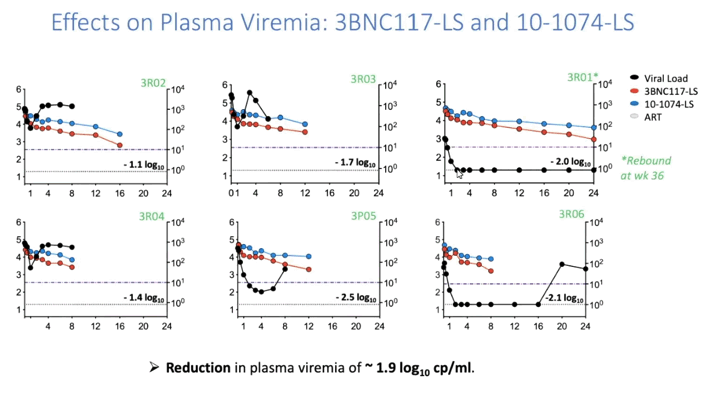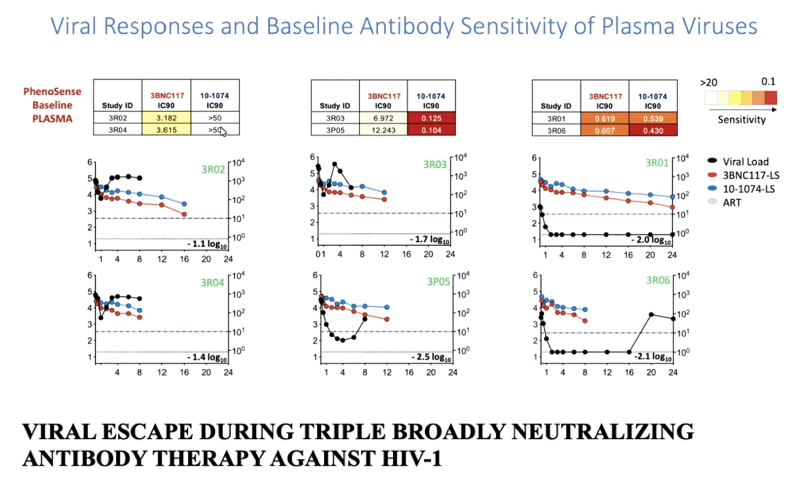 |
 |
 |
| |
Triple & Double bNAbs Studies
|
| |
| |
CROI 2022 Feb 11-16
CROI: Phase 1 Study of Long-Acting 3BNC117 and 10-1074 in Viremic Adults Living With HIV (02/16/22)

had transient suppression, the 1st 4 patients on the left.
had full [left panel] or partial [2nd from left] resistance to one of the antibodies.
the 2 [right panel] with full suppression had low IC90 or full sensitivity to antibodies. lower viral loads may respond better. "may have to do genotyping before treatment to test for sensitivity", Dr Juelg said in response to a question. There appear to be questions around if an assay can predict outcome. "with the antibodies we have now even with 3, we are not achieving the optimal suppression with these studies, I don't see a role with naives or viremic but we've seen more success coming off ART- switch study, we expect with the LA modified antibodies - and these studies are now longer - in the context of an ART interruption will be able to maintain suppression in the right set of individuals that do not have preexisting resistance to the 2 antibodies if the antibodies are given I don't know, every 4-6 months for example, these studies are ongoing", Marina Caskay.

CROI 2022
Boris Juelg1, Kathryn E. Stephenson2, Kshitij Wagh3, Victoria E. Walker-Sperling2, Tom Hassell4, Allen DeCamp5, Elena E. Giorgi3, Richard A. Koup6, John R. Mascola7, Roberto C. Arduino8, Edwin DeJesus9, Nicole L. Yates10, Michael Seaman2, Bette Korber3, Dan Barouch2
1Massachusetts General Hospital, Boston, MA, United States, 2Beth Israel Deaconess Medical Center, Boston, MA, United States, 3Los Alamos National Laboratory, Los Alamos, NM, United States, 4International AIDS Vaccine Initiative, New York, NY, United States, 5Fred Hutchinson Cancer Research Center, Seattle, WA, United States, 6National Institute of Allergy and Infectious Diseases, Baltimore, MD, United States, 7National Institute of Allergy and Infectious Diseases, Rockville, MD, United States, 8University of Texas at Houston, Houston, TX, United States, 9Orlando Immunology Center, Orlando, FL, United States, 10Duke University, Durham, NC, United States
Background:
HIV-1 therapy with single or dual broadly neutralizing antibodies (bNAbs) has shown viral escape, indicating that at least a triple bNAb therapy may be needed for robust suppression of viremia. We hypothesized that at least a triple bNAb therapy may be necessary for robust suppression of viremia. Complementary viral coverage resulting in extended breadth and potency has been modeled for multiple bNAb combinations and the combination of the CD4bs antibody VRC07-523LS, the V3-glycan antibody PGT121 and the V2-apex antibody PGDM1400 has been identified to cover 99% of cross clade strains of which 82% would be covered with at least 2 active antibodies (at IC80 of <10ug/ml).
Methods:
To determine whether the triple combination of PGDM1400, PGT121 and VRC07-523LS is safe and active against HIV in humans, we initiated a two-step phase 1 study: Part 1 was a single-center, randomized, double-blind, dose-escalation, placebo-controlled trial to evaluate three intravenous doses of PGDM1400 alone or in combination with PGT121 (3, 10, and 30 mg/kg per antibody, respectively) in adults without HIV. Part 2 was a multi-center, open-label trial of a single intravenous (IV) administration of 20 mg/kg of PGDM1400, PGT121 and VRC07-523LS each or a single infusion of 30 mg/kg of PGDM1400+PGT121 each, in viremic adults with HIV not on ART. Clinicaltrials.gov #: NCT03205917
Results:
PGDM1400 was safe and well tolerated at doses up to 30 mg/kg and when given in combination with PGT121 and VRC07-523LS. • Half-life 21 days (11 days in viremic PWH). A single infusion of 20 mg/kg of each of the three antibodies reduced plasma HIV RNA levels in viremic individuals by a mean of -2.04 Log10 HIV RNA drop by day 7 copies/ml, however, viral rebound occurred within a median of 20 days post nadir (range 13 and 70). Viruses present before antibody administration were all susceptible to VRC07-523-LS and in many cases were susceptible to PGT121 and PGDM1400. Rebound viruses demonstrated partial to complete resistance to PGDM1400 and PGT121, while susceptibility to VRC07-523-LS was largely preserved. Viral rebound occurred despite mean VRC07-523LS serum concentrations of 93 μg/ml.
Conclusion:
To our knowledge, this is the first report of a triple antibody combination in humans for the treatment of HIV. While PGDM1400 and the combination of all three bNAbs were safe and well tolerated, our data highlight the critical requirement of broad antiviral activity and high serum concentrations that bNAb combinations need to achieve in order to maintain control over the virus.
|
| |
|
 |
 |
|
|